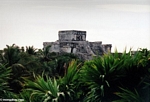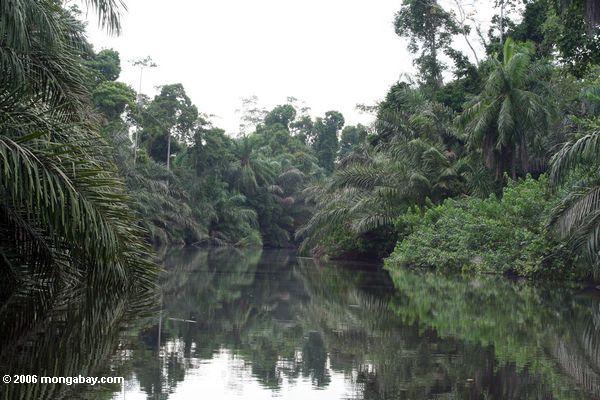The Congo rainforest today in Gabon. Photo by: Rhett A. Butler.
Three thousand years ago (around 1000 BCE) several large sections of the Congo rainforest in central Africa suddenly vanished and became savannah. Scientists have long believed the loss of the forest was due to changes in the climate, however a new study in Science implicates an additional culprit: humans. The study argues that a migration of farmers into the region led to rapid land-use changes from agriculture and iron smelting, eventually causing the collapse of rainforest in places and a rise of grasslands. The study has implications for today as scientists warn that the potent combination of deforestation and climate change could flip parts of the Amazon rainforest as well into savannah.
“To some extent, this large scale deforestation event shaped the African rain forest into its present-day vegetation patterns,” writes the paper’s authors, adding that “the consensus is that the forest disturbance was caused by a regional climate change. However, this episode of forest clearance occurred contemporaneously with the migration of Bantu-speaking peoples from near the modern Nigeria-Cameroon border.”
Recent archeological evidence has found ceramics, stone tools, and the remnants of domestic agriculture, such as oil palm nuts. Iron-working furnaces, which would have been fueled by felled trees, have also been found. But, the researchers wonder what came first: the savannah or the farmers?
In order to determine if the ancient farmers, who lived during the time when David became King of the Israelites, had impacted the rainforest, researchers turned to the sediments of the Congo River. Retrieving a sediment core going back 40,000 years, the researchers found a sudden intensification of chemical weathering that peaked around 1,500 BCE. The weathering event was higher than anytime over the core’s 40,000 record. Chemical weathering is usually connected to natural patterns, such as precipitation and physical weathering, however soil erosion caused by intensive agriculture and deforestation can also cause spikes in chemical weathering. In addition, if climate were solely responsible, researchers would expect to see a drop, not a rise, in chemical weathering due to a drying climate. Instead they found the opposite, pointing to human influence.
The researchers write that they are not yet able to determine to what extent the decline of rainforests was due to human deforestation and how much to climatic changes, but the sudden apex in chemical weathering “clearly suggest(s) that the environmental impact of human population in the central African rainforest was already significant.”
Recent research has warned that the Amazon may be undergoing a similar shift as that of the Congo three thousand years ago. A combination of deforestation for cattle ranching and soy, forest degradation due to extractive industry and roads, purposefully-set fires, and climate change appears to be weakening the resilience of the Amazon rainforest. Scientists fear that the combined impacts could lead to dieback in portions of the Amazon ecosystem, turning over 40 percent of the primary rainforest into savannah. This could have drastic impacts on biodiversity, carbon sequestration, and regional weather patterns as the Amazon produces much of its own rain. Already, in 2005 and 2010 the Amazon rainforest suffered unprecedented droughts with warmer temperatures in the Atlantic Ocean reducing rainfall for the Amazon basin.
“Considerable uncertainty remains surrounding the impacts of climate change on the Amazon,” Dr. Simon Lewis, who has studied the droughts, said last year; but, he added, there is “a body of evidence suggesting that severe droughts will become more frequent leading to important consequences for Amazonian forests. If greenhouse gas emissions contribute to Amazon droughts that in turn cause forests to release carbon, this feedback loop would be extremely concerning. Put more starkly, current emissions pathways risk playing Russian roulette with the world’s largest rainforest.”
CITATION: G. Bayon; B. Dennielou; J. Etoubleau; E. Ponzevera; S. Toucanne; S. Bermell. Intensifying Weathering and Land-Use in Iron Age Central Africa. Science. 2012.
Related articles
Evidence mounts that Maya did themselves in through deforestation

(12/08/2011) Researchers have garnered further evidence for a smoking gun behind the fall of the great Maya civilization: deforestation. At the American Geophysical Union (AGU) conference, climatologist Ben Cook presented recent research showing how the destruction of rainforests by the Mayan ultimately led to declines in precipitation and possibly civilization-rocking droughts. While the idea that the Maya may have committed ecological-suicide through deforestation has been widely discussed, including in Jared Diamond’s popular book Collapse, Cook’s findings add greater weight to the theory.
(08/31/2009) William Ruddiman has become well known for his theory that human-induced climate change started long before the Industrial Age. In 2003 he first brought forth the theory that the Neolithic Revolution-when some humans turned from hunter-gathering to large-scale farming-caused a shift in the global climate 7,000 years ago.
Ancient Amazon fires linked to human populations
(02/20/2008) Analysis of soil charcoal in South America confirms that from a historical perspective, fire is rare in the Amazon rainforest, but when it does occur, it appears linked to human activities. The research, published in Philosophical Transactions of the Royal Society B, is based on dating of soil carbon, which provides a good indication of when fires occurred in Amazonia, according to lead author Mark Bush, head of the Department of Biology at Florida Institute of Technology.
